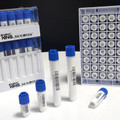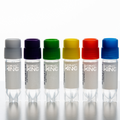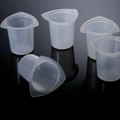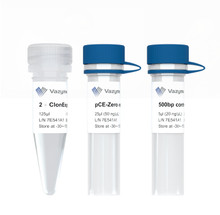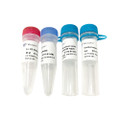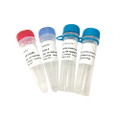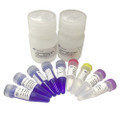 Loading... Please wait...
Loading... Please wait...- Home
- Vazyme
- Reagents for Molecular Biology Research
- Cloning/Mutagenesis
- ClonExpress Ultra One Step Cloning Kit C115
Product Description
Product Introduction
ClonExpress Ultra One Step Cloning Kit is a new generation of recombinant cloning kits, compatible with 1 - 5 fragments homologous recombination. The unique ligase-independent system of this kit significantly reduces the self-ligation background of the vector. Restriction endonuclease sites do not need to be considered. Highly optimized 2 × ClonExpress Mix (It contains enhanced recombinase Exnase) can significantly improve the recombination efficiency and the tolerance to impurities. pCE-Zero vector is compatible with most PCR products, enabling the specific PCR products to be used directly for recombination without any treatments, which significantly simplify the procedure.
Citation
Product Advantages
Simple, fast, efficient, suitable for any carrier;
No need to consider the restriction site carried by the insert;
Efficient cloning of 50 bp-10 kb DNA fragments;
Linearized cloning vector and PCR products can be cloned directly without purification;
No ligase, no self-connection, positive rate >95%
Components

Storage
All components should be stored at -20℃ for up to 18 months.
▲avoid repeated freezing and thawing.
FAQ
Q1: How to design primers?
A primer consists of homology arm (15 – 20 bp, excluding the enzymatic digestion site and base residues, GC content 40% – 60%) + enzymatic digestion site (retain or remove as needed) + specific primer (primer Tm is determined by the specific sequence and does not take into account the homology arm or digestion site)
Primer design: The primer design software, CE Design, is available on the official website. Select the appropriate module for primer design.
Vectors can be linearized by double digestion, single digestion, and inverse PCR. Double digestion is preferred.
Q2: The positive control has few or no colonies.
Incorrect antibiotic plates: The control vectors provided in C112 and C113 are Amp+ resistant, while those provided in C115 are Amp+/Kan+ resistant.
Low efficiency of transformation to competent cells: Ensure transformation efficiency is > 107 cfu/μg. A simple test can be conducted as follows to determine the efficiency: transform 1 ng of plasmids into 100 μl of competent cells and plate 1/10 of the cells; if 1,000 colonies are counted, the transformation efficiency is estimated to be 107 cfu/μg. The volume of recombinant product used for transformation should not exceed 1/10 of the competent cell volume, or the transformation efficiency will be reduced. Use competent cells for cloning (such as DH5α/XL10) instead of ones for protein expression.
Q3: The plate has no clones/few clones/empty vectors.
Positive control: Use a positive control to rule out causes such as problematic technique or reduced competent cell titer or reduced enzyme activity that may result in a low recombination efficiency.
Incorrect primer design: Primers should include a 15 – 20 bp homology arm (excluding the enzymatic digestion site) and have a GC content of 40% – 60%. If the homology arm is shorter than 13 bp or longer than 35 bp, there will essentially be no recombinant activity. If the arm is longer than 25 bp, the recombination efficiency will be significantly decreased. If the GC content is too high or too low, it will impair the recombination efficiency.
Vector linearization: Prefer double digestion. Extend the digestion time for rapid digestion (digest overnight if the enzyme has no star activity); decrease the plasmid input amount; purify by gel extraction to reduce uncut vectors; use a negative control to verify the extent of vector linearization.
No gel extraction to purify vectors or inserts: Unpurified DNA may inhibit the recombination reaction. Purify linearized vectors and PCR products by gel extraction and dissolve the purified products in ddH2O.
Inaccurate concentration measurement for linearized cloning vectors and inserts: If using a NanoDrop spectrophotometer to measure their concentrations, make sure that their concentrations are higher than 20 ng/μl and that the OD260/280 ratio is around 1.8, which can ensure accurate measurements. Otherwise, run a gel to determine the concentrations of cloning vectors and inserts, or prepare new fragments (combine multiple tubes and concentrate the mixture to increase the recovery concentration).
Insufficient/excess linearized cloning vectors and amplified inserts (inappropriate ratios): Prepare the recombination system in strict accordance with the amounts and ratios recommended in the Instructions for Use. At least 1 μl of each component should be used (to avoid pipetting errors resulting from insufficient volumes).
Recombination system: For C112/C113, use a 20 μl recombination system. A 10 μl system may result in a low recombination efficiency.
Recombination conditions: Perform the recombination using precise instruments, such as PCR systems and thermal shakers, instead of water baths and incubators, which may reduce the recombination efficiency due to inaccurate temperature control.
The transformation efficiency of competent cells should be higher than 107 cfu/μg. The volume of recombinant product used for transformation should not exceed 1/10 of the competent cell volume, or the transformation efficiency will be reduced. Use competent cells for cloning (such as DH5α/XL10) instead of ones for protein expression. If homemade competent cells are used, measure their titer (transform 1 ng of plasmid into 100 μl of competent cells and plate 1/10 of the cells. If 1,000 colonies are counted, the transformation efficiency is estimated to be 107 cfu/μg) and plate all competent cells; set the correct temperature for competent cell transformation.
Additional methods to enhance the recombination efficiency: For C112, decrease the vector and insert input amounts by half.
Check whether the correct antibiotic plate is used.
Q4: False positives/no sequencing signals/empty vectors
Negative control: Use a negative control to rule out false positives caused by residual cloning vectors. The presence of a large number of clones in the negative control group suggests excess template input or no DpnI digestion.
Obtain fragments/vectors using plasmids as PCR templates: Do not input excess plasmids (< 1 ng), or false positives may arise due to incomplete DpnI digestion. Purify PCR products by gel extraction and dissolve the purified products in ddH2O (pH 8.0).
Selection of colonies: Pick both large and small colonies from a certain region on the plate for the following reasons: Recombination products with unligated 3' and 5' ends need to be repaired in competent cells, resulting in smaller colonies; uneven distribution of nutrients in the plate will lead to differences in colony size; compared with original plasmids, recombinant plasmids may impede cell growth. Therefore, it is recommended to pick both large and small colonies to increase the chance of selecting recombinant products.
Primers for colony PCR: Use universal primers for vectors or primers with one end on the vector and the other end on the target fragment. If target fragment primers are used for colony PCR, it is possible to have positive results for colony identification but no sequencing results.
Q5: Colony PCR does not give bands.
(1) Inappropriate PCR system or program: Optimize the PCR system and program if there are no bands for targets or empty plasmids. Alternatively, extract plasmids and use them as the template to verify PCR or enzymatic digestion.
(2) Recombination failure: The presence of bands for empty plasmids only indicates unsuccessful recombination due to incomplete vector linearization. Optimize the enzymatic digestion system and review primer design.
(3) Unsuitable PCR kit: The kit is unsuitable for crude samples, or the amplified fragment is too large and its size is out of the application scope of the kit.
Q6: Most clones contain incorrect inserts.
(1) PCR yields non-specific products: Optimize the PCR system to enhance specificity; gel extract PCR products; verify more clones.
(2) Plasmids with the same antibiotic resistance have been introduced into the reaction system: When circular plasmids are used as the PCR template, digest the amplification products with DpnI if the products are directly used for recombination, or purify the products by gel extraction.
Q7: The insert has base mutations.
Number of samples sequenced: The sequencing results of only one sample may not be reliable. Please sequence more samples.
Analyze sequencing results: Check the signal at the mutations. The presence of double peaks or non-specific miscellaneous peaks may denote unreliable sequencing results.
Check the mutation site: If the mutation site is the same across multiple sequencing runs, the mutation may be introduced through the template, or the template sequence may differ from that on NCBI.
Use high-fidelity polymerase to obtain inserts by PCR.
The base mutations of primers may result from primer synthesis. Please re-synthesize primers for the experiment.





